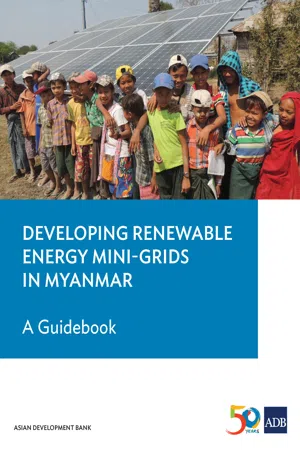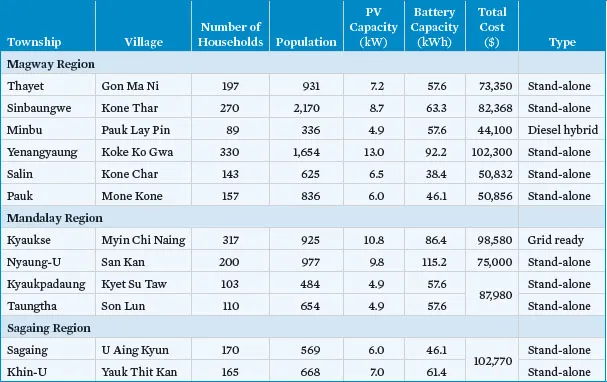![]()
1
Introduction
This guidebook documents the experiences and lessons learned from the Off-Grid Renewable Energy Demonstration Project, an Asian Development Bank (ADB) technical assistance project in Myanmar, which was financed by the Japan Fund for Poverty Reduction. The project was completed with the Ministry of Agriculture, Livestock, and Irrigation (MOALI)1 as the executing agency and the Department of Rural Development (DRD) within the ministry as the implementing agency.
ADB supported DRD, along with regional and local government agencies, to design and implement an off-grid renewable energy demonstration project that included three main components: (i) pilot mini-grids, (ii) a geospatial planning and off-grid investment plan, and (iii) a capacity-building program to strengthen the government’s capacity in mini-grid development.
Pilot Projects
Under the project, solar mini-grid systems were successfully installed in 12 villages located in the country’s Dry Zone (Magway, Mandalay, and Sagaing regions). These consist of 10 stand-alone projects, 1 diesel hybrid system, and 1 project built to grid standards so that it can be connected to the national grid when it arrives in the village (Table 1).
The ADB project funded 80% of the installation costs, while the villagers contributed the remaining 20%. After a tendering process, the Project awarded the contracts to install the systems to two local solar vendors (SolaRiseSys and Zaburitz Pearl). For each community, a Village Electrification Committee (VEC) was established. These VECs are responsible for payment collection from the villagers. The vendors have the responsibility to maintain the systems for 3 years. At the end of the first 3 years, the vendors will also replace the batteries with new ones, or provide the communities with a new set of batteries that can be installed at a later stage.
This guidebook documents the main experiences and lessons learned from the 12 pilot projects, as well as training materials from the capacity-building activities. It is intended to serve government officials, renewable energy developers, and potential investors in the development of mini-grid projects in Myanmar.
Table 1: pilot projects with Renewable energy Mini-grids
kW = kilowatt, kWh = kilowatt-hour, PV = photovoltaic.
Source: ADB Myanmar Off-Grid Renewable Energy Demonstration Project Team (2017).
The guidebook is structured as follows:
• Section 2 discusses major aspects of mini-grid development for rural electrification in Myanmar.
• Section 3 discusses the importance and approaches of community participation and gender mainstreaming in mini-grid projects.
• Section 4 summarizes the main lessons learned from the implementation of the 12 pilot projects.
• Section 5 discusses the main renewable energy technologies that are suitable for mini-grid development in Myanmar (solar, hydro, and biomass).
![]()
2
Aspects of Mini-Grid Development
The following sections discuss major aspects of mini-grid development for rural electrification in Myanmar and incorporate the main experiences from the pilot projects.
2.1 Site Identification and Selection
Site selection should aim to identify unelectrified rural communities without prospects of being connected to the national grid in the next 5–10 years. These are typically located at least 10 kilometers from the national grid.
Under the National Electrification Plan, the Ministry of Electricity and Energy2 has developed three subsequent phases of grid rollout, identifying villages that are recommended for grid connection in each phase. This should be a first-pass check on the suitability of a village for a mini-grid.
In addition, a village should also have sufficient demand for electricity and consist of a concentrated group of at least 150–200 households to make a mini-grid viable. Larger villages are preferable as these will be able to provide stronger revenue streams that will help sustain the mini-grid operation in the long run.
The existing sources of lighting and how much the villagers spend for lighting are also important considerations. If they depend on kerosene or candles, they might be more interested in renewable energy mini-grids. If they have a diesel-based mini-grid, the addition of a renewable component may lower the cost of generation. However, if several households in a village already have a solar home system installed (either from a Department of Rural Development [DRD] program or self-purchased), development of a mini-grid may not be feasible as these households may not be willing to contribute toward a mini-grid scheme.
For the pilot projects, selecting villages and maintaining their interest in participating in the project were major challenges. Discussions were held with more than 35 villages to find 12 suitable villages. Villages were not interested in participating for various reasons. For example, some are located relatively close to the national grid and were expecting to get connected soon. A number of villages were not willing or able to contribute their share of the project cost, or were not able to come to an agreement internally. One village decided not to participate even after signing the contract with the vendor. Therefore, programs or developers targeting multiple villages should identify a sufficiently large number of villages from an early stage so that replacement villages can be identified if needed.
For the pilot projects, the following criteria were used to identify suitable villages:
• at least 2 miles (3.22 kilometers) from the national grid and low likelihood of grid connection in the next few years
• not part of DRD’s national rural electrification program
• number of households higher than 200 and houses not scattered widely
• sufficient cohesiveness among the villagers to form a VEC and manage the project as a community
• ability and willingness of the villagers to contribute 20% of the projects costs and to pay for the electricity services
• ease of accessibility of the village, to bring in the equipment
Table 2 and Figure 2 show the results of a geospatial analysis that classified villages by distance from the existing electricity grid in the Dry Zone (Magway, Mandalay, and Sagaing regions). This shows that particularly in Magway and Sagaing there is a large number of villages located at more than 10 kilometers from the grid, indicated as red dots.
Table 2: Unelectrified villages in the Dry Zone
Source: ADB Myanmar Off -Grid Renewable Energy Demonstration Project Team (2017).
To support the identification of suitable sites for mini-grids, the project has developed a web-based geospatial mapping tool. The tool maps unelectrified villages in the Dry Zone and provides information on available local resources and nearby infrastructure for an estimation of the potential for off-grid investments. Users can select a variety of parameters, such as population, existing infrastructure, and natural resources, to interactively analyze the potential for off-grid electrification in Magway, Mandalay, and Sagaing regions (http://adbmyanmar.integration.org/).
2.2 Resource Assessment and Technology Selection
Several renewable energy technologies are suitable for mini-grids, as long as sufficient resources are available. These resources are typically site specific and may fluctuate seasonally. Therefore, it is crucial to conduct a proper resource assessment before choosing a particular technology. Preferably this should be carried out by experts with experience in assessing resources for a specific technology.
Renewable energy technologies suitable for mini-grids in Myanmar include solar, hydro, and biomass.3 The most suitable technology will vary from project to project, but will foremost depend on sufficient resources available for electricity generation. Generally speaking, solar resource data can be obtained from indirect sources such as satellite data and nearby weather stations, while hydro and biomass require on-site measurements and investigation to assess available resources.
Regardless of the resource, all types are subject to seasonal variations that need to be carefully considered. Under the right circumstances, hydro and biomass can provide higher loads and longer hours of service compared to solar mini-grids. However, they also require more elaborate resource assessments and feasibility studies, which can be a lengthy and costly process. This may limit the ability of communities to implement such projects.
Solar
Myanmar has an average solar irradiance of 4.5–5.1 kilowatt-hours per square meter per day (kWh/m²/day), making solar a suitable technology for mini-grids in many locations. Nevertheless, strong variations exist in the different areas of the country. Solar irradiance at a particular site can be obtained from on-site measurements, or derived from satellite data and nearby weather stations.
Figure 3 shows the solar irradiance in Myanmar from month to month. This clearly shows a strong variation between the dry and rainy seas...




